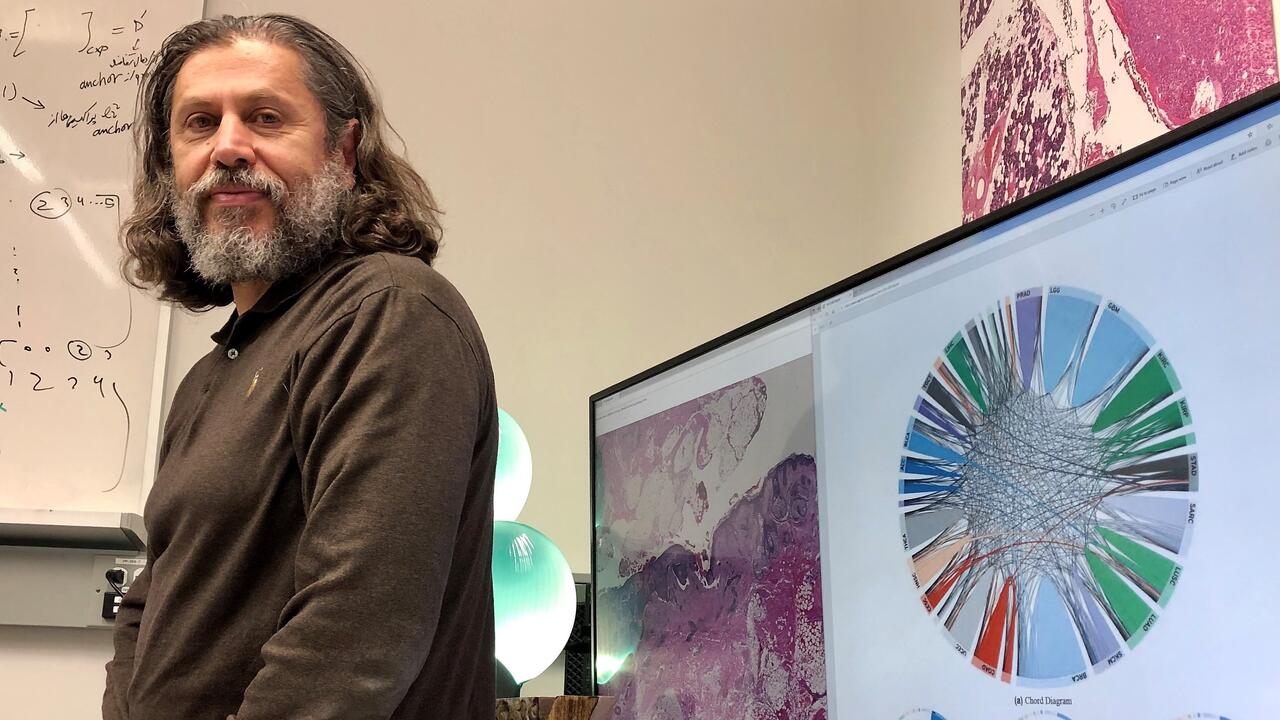
Tapping human wisdom using AI
Powerful new technology developed at Waterloo Engineering promises faster, better diagnosis of all kinds of cancer via AI-enabled search of verified cases

Powerful new technology developed at Waterloo Engineering promises faster, better diagnosis of all kinds of cancer via AI-enabled search of verified cases
By Brian Caldwell Faculty of EngineeringA new system that combines artificial intelligence (AI) with human knowledge promises faster and more accurate cancer diagnosis.
The powerful technology, developed by a team led by researchers at Waterloo Engineering, uses digital images of tissue samples to match new cases of suspected cancer with previously diagnosed cases in a database.
In tests using the largest publicly available archive in the world – comprised of about 30,000 digitized slides from almost 11,000 patients – the technology achieved up to 100-per-cent accuracy for 32 forms of cancer in 25 organs and body parts.
“AI can help us tap into our medical wisdom, which at the moment is just sitting in archives,” says Hamid Tizhoosh, director of the Laboratory for Knowledge Inference in Medical Image Analysis (KIMIA Lab) at Waterloo. “When you use AI like this, its performance is astounding.”
The system utilizes AI to search digital images of biopsies from confirmed cancer cases for those most similar to a new digital image in an undiagnosed case.
Based on the known, verified findings of the majority of similar images, the system recommends a diagnosis for the new case.
Conducted over a four-month period using high-performance computers and data storage, the tests achieved accurate diagnoses for everything from melanoma to prostate cancer.
“We showed it is possible using this approach to get incredibly encouraging results if you have access to a large archive,” says Tizhoosh. “It is like putting many, many pathologists in a virtual room together and having them reach consensus.”
The archive used in the study, part of a five-year project backed by $3.2 million in funding from the Ontario government, was provided by the National Cancer Institute in the United States.
More work is needed to analyze the findings and refine the system, but Tizhoosh says the results so far demonstrate it has potential as a screening tool to both speed up and improve the accuracy of cancer diagnoses by pathologists.
And in the developing world, it could save lives by enabling remote access to inexpensive diagnosis.
“This technology could be a blessing in places where there simply aren’t enough specialists,” Tizhoosh says. “One could just send an image attached to an email and get a report back.”
Project sponsor Huron Digital Pathology of St. Jacobs, Ontario is currently working to commercialize the technology.
A paper on the research, Pan-Cancer Diagnostic Consensus Through Searching Archival Histopathology Images Using Artificial Intelligence, appears in the journal Nature Digital Medicine.

Read more
Here are the people and events behind some of this year’s most compelling Waterloo stories

Engineering master's student Nayeema Nonta (left), one of the three paper authors, and her supervisor, Dr. Sirisha Rambhatla, in a large server room with the computer power needed to develop their new LLM training technique. (University of Waterloo)
Read more
Waterloo researchers develop highly efficient AI training system that paves the way for cheaper, greener “intelligent partners”

Read more
Engineering researchers team up to tackle the plastics pollution problem with microbial innovation and engineering design
Read
Engineering stories
Visit
Waterloo Engineering home
Contact
Waterloo Engineering
The University of Waterloo acknowledges that much of our work takes place on the traditional territory of the Neutral, Anishinaabeg, and Haudenosaunee peoples. Our main campus is situated on the Haldimand Tract, the land granted to the Six Nations that includes six miles on each side of the Grand River. Our active work toward reconciliation takes place across our campuses through research, learning, teaching, and community building, and is co-ordinated within the Office of Indigenous Relations.